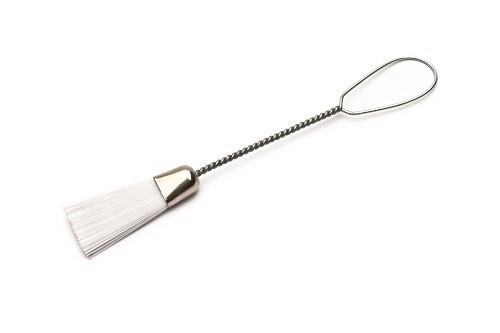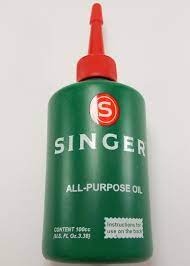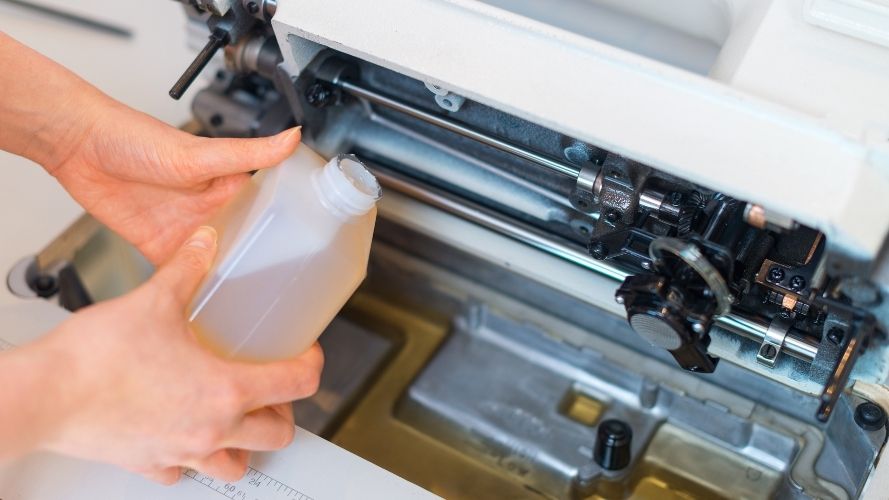There are older sewing machines that require periodic lubrication of the mechanical workings. New devices are permanently lubricated at the factory and need, in most cases, no further lubrication.
Stop!
Before going any further, if you haven’t yet checked your user manual, go ahead and do that. Refer to the links below to find your brand’s online manual. There you’ll learn whether and how to oil your personal machine.
Go.
Okay, so you are sure that you need to oil your machine – now what?
Clean often and before you lubricate
You must clean your machine in the area under the needle plate often, about once every 10 hours of sewing. Remove the needle plate and use your nylon sewing machine brush to remove all lint, stray threads, or tiny pieces of fabric. You can also use the same air spray cans that you use for your computer.

Use the right sewing machine oil
If your sewing machine is under warranty, the manufacturer will probably insist that you use their brand of lubrication. If you don’t, you run the risk of invalidating your warranty. Oil and lubricants are a pretty low-cost item. It isn’t worth the chance to buy another until the warranty period expires; then, buy which brand you will.

Never substitute sewing machine oil with any other product.
Never try to substitute other oils for sewing machine oil. These can permanently damage your machine. The following might occur to you, but I warn you never to use these.
- 3-in-1 oil
- Motor oil
- Vegetable oil
- Graphite
- Alcohol cleaners
- Petroleum jelly
- Any wax
- Furniture polish
- All-purpose grease
- Auto or household silicone spray
Using these or similar products instead of the recommended specialized sewing machine oil will cause irreparable harm. You won’t save any money. Sewing machine oil costs less than $5 and lasts a long time. If your machine needs oiling, be sure to have a tube of the right product on hand to use when needed.
What to do if you need to oil your machine regularly
If you do need to oil your machine, here is a handy formula courtesy of SINGER Corporation that explains how often.
- If you use your machine every day, clean and oil your machine three times each week.
- If you sew once a week, clean and oil once each month.
- If you use your machine once every month, clean and oil it every three months.
If your machine is factory pre-lubricated
If you want or need to do so, you can carefully oil the bobbin case area and the needle bar with 2 to three drops of sewing machine oil. You can also lubricate the handwheel on the side of the machine.
If your machine makes grinding noises or you haven’t used it in a long while, however, take it to a service center to be repaired before you use it again.
Be careful not to over-lubricate the machine. Over-oiling may harm the machine and make your threads tangle and, of course, become pretty oily, which will damage thread and fabric.
How to oil your sewing machine
First, whenever you work on your machine, unplug it. To find your machine’s mechanics, use the sewing machine’s screwdriver made for the plate. You may have received the tool with your sewing machine. You can also purchase the inexpensive tool at any sewing department.
The difference between an ordinary household screwdriver and one made for sewing machines is the height of the handle. To fit correctly under the arm of the machine, the screwdriver is shorter to accommodate that shortened height.
After you remove the needle plate, you will need to remove the bobbin case. Set the bobbin case aside.
Holding the handwheel located on the right side of the sewing machine, turn the wheel a quarter to half a turn. Look at the working parts under the needle plate and note where two parts are meeting when you make those turns.
Put a drop of sewing machine oil on the parts which are rubbing together. After using the oil, keep moving the wheel back and forth to evenly distribute the oil.
You may want to put a drop of oil in the handwheel to ensure it continues to work efficiently.
After the lubrication is finished, place a full bobbin into the bobbin casing. Thread the machine, then sew a cotton fabric until any trace of excess oil is gone. Use a fabric that is a natural absorbent, such as cotton or denim.
What’s the worst that can happen if the machine isn’t lubricated?
You can make sure your machine quits working at all. Sewing, quilting, serger, and embroidery machines are hi-tech precision tools. Just because they fit on a small table doesn’t mean they are any less powerful than a household’s other tools. They all need the same kind of care and attention to work correctly and consistently.
If a sewing machine requires periodic oiling and has been stored in a basement for a decade, don’t use the machine before you have it professionally serviced. The old oil may well be hardened to the point where the device is ‘frozen.’ If you can’t turn the manual wheel on the machine, don’t try to fix this yourself. Find a reputable dealer who can service your brand and type of machine.
Suppose you try to sew with a machine that needs oil but isn’t properly lubricated. You can, again, damage the device permanently.
Give your machine a good checkup while you’re at it.
While you are taking time to take care of your machine, other chores need to be done periodically. This is an excellent time to take care of each of them before you sew again.
- Wipe the machine down with a damp cloth using plain water, then dry.
- If your machine has a rubber belt on the side handwheel, check that it is not frayed or too loose. If the belt has issues, replace it following your owner’s manual.
- Inventory your consumable sewing machine parts. These include belts, sewing machine oil, and light bulbs. When one needs replacing, you don’t want to have to go to the store or order a replacement before you can sew.
- If you don’t have a cover for your sewing machine, try to invest in at least a cloth covering. Keeping your sewing machine protected will keep dust and lint away.
How to Oil Any Home Sewing Machine
Some machines need oiling, and some do not. Learn whether and how to lubricate your sewing machine.
There are older sewing machines that require periodic lubrication of the mechanical workings. New devices are permanently lubricated at the factory and need, in most cases, no further lubrication. Refer to the links below to find your brand. You’ll find out whether and how to oil your personal machine.
Sewing Machine Manuals Reference
- SINGER: https://www.singer.com/support?title=manual
- Brother: https://help.brother-usa.com/app/answers/detail/a_id/55210/~/how-to-locate-the-users-manual
- Janome/Elna: https://www.janome.com/support/manuals/
- Huskvarna/Viking: https://www.husqvarnaviking.com/Support
- Bernina: https://www.bernina.com/en-US/Support-US/Out-of-Print-Manuals/BERNINA-manuals/BERNINA-Sewing-Systems
- Pfaff: https://www.pfaff.com/en-US/Support-and-Updates/Support
- Baby Lock: https://babylock.com/support/machine-support


